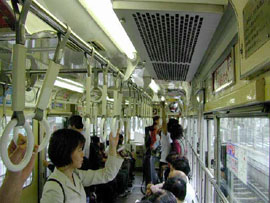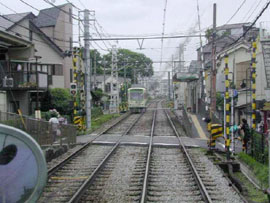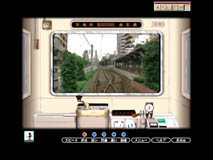Let's Take the Streetcar!
While sitting at my desk one recent morning and taking a moment to yawn and scratch the side of my face, junior reporter Junko burst into my office from the newsroom as she usually does - without knocking.
"We have a new assignment! Prime Minister Yoshiro Mori just called!" she exclaimed.
 I adjusted my Godzilla cufflinks before reaching into my pocket for my pack of smokes.
I adjusted my Godzilla cufflinks before reaching into my pocket for my pack of smokes.
She continued, "We are to research the last remaining Tokyo streetcar - the Toden Arakawa Line. It seems Mr. Mori wants to build a similar streetcar line in his home prefecture of Ishikawa."
I put my feet up on my desk and asked, "Doesn't he have a government transportation think tank for that?"
"Yeah, but right now they are bit overwhelmed in ensuring that Mitsubishi isn't building its cars with Play-Doh."
Though at that point completely satisfied with the reasoning behind the request for our services, the specific subject matter seemed to be a bit odd, at least based on some of my past research into Japanese train projects.
"Let's see," I said, "I seem to remember reading about this recently, something about pigs, I believe." I started digging through my file drawer. "Ah, here it is." I threw a copy of the Far East Economic Review onto my desk. I then began to run my finger along the edge of my lighter.
Junko picked it up and read:
Pork-Barrel Express
For much of the world, the bullet train has come to symbolize Japan and its technological prowess. For some Japanese, however, the unending quest for new routes is a symbol of something else - pork-barrel spending that's more political than practical. The Hokuriku line, which will run through Kanazawa and along the Sea of Japan coast, is one of these.
The government has yet to bless the plan, but Yoshiro Mori, secretary-general of the LDP and a native of the Hokuriku region, says he expects "quite a bit" of money to go toward new bullet trains in a supplemental budget now being compiled.
 "Now this article is about a bullet train," I said. "There is no mention of a streetcar." I pointed at her with my cigarette after taking my first puff.
"Now this article is about a bullet train," I said. "There is no mention of a streetcar." I pointed at her with my cigarette after taking my first puff.
"Yeah, but this is old news. In this article Mori wasn't even the PM yet."
"So now that he is the biggest cat in town he wants a street car and not a bullet train. Why the change?"
"Well, on the phone, he indicated that he likes the 'ching ching' sound the streetcars make."
Nationwide 20 streetcar lines remain in service. At their peak just before WWII, 82 companies operated 1,479 kilometers of track in 65 regions of Japan. Tokyo itself provided service for nearly two million people. Today, things are a bit different with Tokyo's single remaining line - the Arakawa Line - carrying a mere 60,000 people a day.
However, this relatively low ridership should not be construed as a measure of the line's popularity. Over its length from Waseda University, the rearing grounds of most Japanese politicians, to Minowabashi, the roaming grounds of many of Tokyo's homeless, the single beige and green-striped cars are endeared by their faithful passengers and the communities through which they travel.
Like the variation in social standing at either end of the track, there is a similarly large variation in the experiences to be had from the standing position in any car as it travels the 40 minutes from end to end. But whether seeing a colorful giant carp maneuver between junked bicycles in the Kanda River or witnessing the very same AM/PM convenience store mentioned in the intercom announcement preceding arrival at Koshinzuka Station, the passenger comes to understand the friendship between this earth ferry and the neighborhoods it serves.
 Perhaps it is best to describe this relationship as a selection of communities refusing to be gentrified, at least on a large scale, and a transportation system that is more than accommodating to their wishes. In comparison to their train and subway brethren, the 50-person capacity cars are small in size, pollution emission, noise, and cost ($1.60 flat rate no matter the distance traveled). These characteristics blend well with many of the neighborhoods, a lot of which haven't changed significantly in 30 years.
Perhaps it is best to describe this relationship as a selection of communities refusing to be gentrified, at least on a large scale, and a transportation system that is more than accommodating to their wishes. In comparison to their train and subway brethren, the 50-person capacity cars are small in size, pollution emission, noise, and cost ($1.60 flat rate no matter the distance traveled). These characteristics blend well with many of the neighborhoods, a lot of which haven't changed significantly in 30 years.
Meandering five-foot wide alleys and paths, unchanged roads from the days of the horse and carriage, ancient temples and gardens, and the backsides of individual housing are some of the changing landscape that can be viewed during one of the streetcar's smooth and slow rides. And unlike typically large and gaudy Tokyo housing, that which lies in proximity of the Arakawa track goes from predominately individual traditional darkened-wood constructed homes with fish scale-patterned shingles to small modern 2-story gray box homes with black trim and imitation tiling. Scattered in between and around are such individually owned businesses as local baths, lumber shops, laundry mats, ramen shops, clothing stores, and many other small-scale craft-related properties.
Perhaps the only constants over the course of the streetcar's full 12.2 km length are the never-ending streams of overhead electrical cables, the banks of protective gravel at the track's edge, and of course the "ching ching" sound as the streetcar pulls from each station.
 But this accommodating manner that the streetcar has with its surroundings should not be taken to be a case of one way love. The community may taketh, in the form of reliable transportation with a minimum of intrusion, but they also giveth. On either side of the track's right-of-way, folks pamper the black and white iron-fenced borders with generous amounts of well-kept flower boxes, climbing roses and ivy, and potted plants. Additionally, near Oji Station, at approximately the track's midpoint, the streetcar actually pulls onto major streets and mingles with the street traffic for a short period. But in this seemingly harsh environment for a one-directional shuttling tram, the trucks, cars, and buses, treat it like, well, a member of the family.
But this accommodating manner that the streetcar has with its surroundings should not be taken to be a case of one way love. The community may taketh, in the form of reliable transportation with a minimum of intrusion, but they also giveth. On either side of the track's right-of-way, folks pamper the black and white iron-fenced borders with generous amounts of well-kept flower boxes, climbing roses and ivy, and potted plants. Additionally, near Oji Station, at approximately the track's midpoint, the streetcar actually pulls onto major streets and mingles with the street traffic for a short period. But in this seemingly harsh environment for a one-directional shuttling tram, the trucks, cars, and buses, treat it like, well, a member of the family.
A few days later, I staggered back into the newsroom. Junko was at her desk staring at her computer.
"Well I just discussed our research over at the PM's office," I said in popping a smoke in my mouth and leaning over her shoulder and staring at the screen.
"Does he still drink whiskey in the afternoon?" she asked. She was a bit distracted by the game she was playing.
"Actually bourbon. And remind me to never refer to him as anything but a generous man from now on. Say, what game are you playing here?"
 "It's called 'Let's Take the Streetcar!' It was created in conjunction with the Tokyo Bureau of Transportation and the Arakawa Line. Pretty realistic with its recreation of the scenery, drivers, tickets, and car interior, wouldn't you say?"
"It's called 'Let's Take the Streetcar!' It was created in conjunction with the Tokyo Bureau of Transportation and the Arakawa Line. Pretty realistic with its recreation of the scenery, drivers, tickets, and car interior, wouldn't you say?"
"Yeah, that's nice but if you hit one more pedestrian, your turn is gonna end." I turned for my office.
"Ok wise guy," she called over her shoulder. "Why don't you just tell me some of his thoughts on this streetcar project?"
I lit my grit. "Well, mostly he kept jabbering on about his recent trip to India and the Taj Mahal. I think it inspired him. Because every time he mentioned this project he kept pounding his fist on his desk and referring to it as: "The eighth wonder of the world!"
I heard a gasp of pain from the newsroom. Junko's turn had ended.

